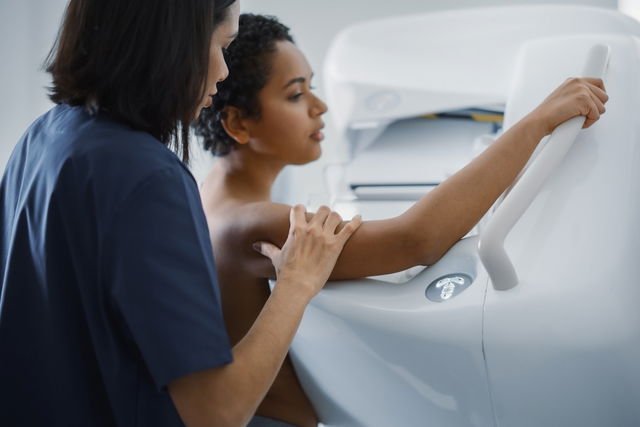A mammogram is an imaging test that is done to visualize the breast tissue. Its main objective to to detect any changes that can indicate the development of breast cancer.
A mammogram is usually recommended for women 40 years of age and up. However, women with a positive family history of breast cancer should have one starting at 35 years of age.
The results of a mammogram can identify benign lesions that do not require treatment, however a mammogram can also pick up small changes that may be early cancer signs. When breast cancer is diagnosed in its early stages, the chances of a cure are significantly improved.

What it’s for
A mammogram is a diagnostic test that looks to investigate for and diagnose breast cancer.
However, this test can also verify the presence of nodules and cysts, and can provide details about their size and characteristics to determine whether they are benign or malignant.
How it’s done
A mammogram is a very simple test, however it can be uncomfortable for the patient. The breast is placed in equipment that applies pressure on the breast in order to obtain a clear image of the breast tissue.
Depending on the size of the breast and its density, the compression time can vary from woman to woman. Some may report more pain and discomfort during the test than others.
Test preparation
To complete a mammogram, there is no specific perspiration needed. Women are advised to avoid using deodorant, baby powder and creams on the chest or armpits to prevent interference with the results.
In addition, women are also advised to avoid booking a mammogram in the days leading up to a period, as breasts tend to be more sensitive during this time, making the test more uncomfortable.
Who should have a mammogram?
A mammogram is recommended a routine screening test for women after 40 years of age. It should be repeated every 1 to 2 years.
Women who have a positive family history of breast cancer should start mammograms after 35 years of age. Although it is often ordered for routine screening, this test may also be ordered if any suspicious findings are noted during a breast exam. If you notice any changes in your breasts when performing a self-exam, like a breast lump, you should report them to your doctor for further assessment.
Common doubts
The most common questions about mammograms include:
1. Can you complete a mammogram with breast implants?
Yes. Although silicone implants may interfere with the image, it is possible for the radiologist to capture the necessary images around the implants. However, more compression may be needed to obtain images.
The doctor may opt to order a digital mammogram for women with implants, which is a more specific test for this population of women. It is associated with less discomfort, as less compressions are required.
2. Is a mammogram the only test that detects cancer?
No. There are other tests, like ultrasound and MRIs, that can be useful for diagnosing breast cancer. Mammograms continue to be the best test for detecting early changes, however, as they can detect early developments of breast cancer which can increase the risk for cure significantly.
3. Can you complete a mammogram if you are breastfeeding?
No. Mammograms are not recommended for women who are breastfeeding or pregnant. Doctors will likely order other tests for these women, like ultrasound and MRI.
4. Are mammogram results accurate?
Yes. A mammogram result is very accurate but it should still be interpreted by the ordering physician, as results may not be fully understood by patients who are not health care professionals. Ideally, suspicious results should be interpreted by a breast specialist.
5. Will breast cancer always appear in a mammogram?
No. Very dense breasts may not capture small nodules, which is why women should also present for physical breast exams in addition to a mammogram. Palpation techniques are able to detect changes like nodules, skin changes, nipple changes, breast pain, and lymph node changes.
If the doctor palpates a nodule, he or she may order a mammogram, even if the patient is not yet 40, as nodules can be a sign of breast cancer.
